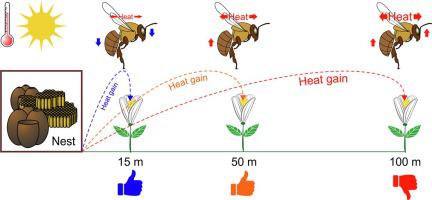当前位置:
X-MOL 学术
›
J. Insect Physiol.
›
论文详情
Our official English website, www.x-mol.net, welcomes your
feedback! (Note: you will need to create a separate account there.)
Increasing thermal stress with flight distance in stingless bees (Melipona subnitida) in the Brazilian tropical dry forest: Implications for constraint on foraging range.
Journal of Insect Physiology ( IF 2.3 ) Pub Date : 2020-05-06 , DOI: 10.1016/j.jinsphys.2020.104056 João Batista Freire Souza-Junior 1 , Vinício Heidy da Silva Teixeira-Souza 2 , Aline Oliveira-Souza 1 , Paloma Fernandes de Oliveira 2 , João Paulo Araújo Fernandes de Queiroz 3 , Michael Hrncir 4
Journal of Insect Physiology ( IF 2.3 ) Pub Date : 2020-05-06 , DOI: 10.1016/j.jinsphys.2020.104056 João Batista Freire Souza-Junior 1 , Vinício Heidy da Silva Teixeira-Souza 2 , Aline Oliveira-Souza 1 , Paloma Fernandes de Oliveira 2 , João Paulo Araújo Fernandes de Queiroz 3 , Michael Hrncir 4
Affiliation

|
The thoracic temperature (TTX) of foraging bees usually exceeds ambient air temperatures (TAIR) by several degrees. In hot tropical climate zones, therefore, individuals may reach body temperatures close to their critical thermal maxima, which might constrain their activity. In the present study, we tested the hypothesis that thermal stress increases with flight distance in nectar foragers of M. subnitida, a stingless bee species native to the hottest regions of the Brazilian tropical dry forest. Using infrared thermography, we recorded the body surface temperature of individuals foraging at distances of 15, 50, and 100 m. Closest to the nests, foragers stabilized TTX at 40 °C when collecting sugar solution at TAIR > 30 °C. The simultaneous decrease of the temperature excess ratio of head and abdomen suggests evaporative cooling at these body parts. With increasing foraging distance, foragers increased heat dissipation to the head and abdomen. Thus, despite more intensive heating of the thorax due to faster and longer flights, the bees maintained similar TTX as foragers at close feeding sites. However, at TAIR > 30 °C, bees could no longer compensate the elevated heat gain at the head (50 m) and abdomen (50, 100 m), which caused an increasing temperature excess in these body parts. Thus, foragers of M. subnitida suffer overheating of the head and abdomen instead of the thorax when foraging in high temperatures at far feeding sites. Consequently, to avoid heat stress in the Brazilian tropical dry forest, the bees should forage close to the nest.
中文翻译:

巴西热带干燥森林中无刺蜂(Melipona subnitida)的飞行距离会随着飞行距离的增加而增加热应力:对觅食范围的限制。
觅食蜜蜂的胸温(TTX)通常比周围空气温度(TAIR)高出几度。因此,在热带炎热的气候带中,个体的体温可能接近其临界热最大值,这可能会限制其活动。在本研究中,我们测试了以下假设:在亚热带天竺葵的花蜜觅食者中,热应激会随飞行距离的增加而增加,该亚种是巴西热带干旱森林最热地区的一种无刺蜂。使用红外热成像技术,我们记录了在15、50和100 m处觅食的个体的体表温度。在TAIR> 30°C时收集糖溶液时,觅食者最靠近巢穴将TTX稳定在40°C。头部和腹部温度过高比率的同时下降表明这些身体部位的蒸发冷却。随着觅食距离的增加,觅食者向头部和腹部的散热增加。因此,尽管由于更快和更长的飞行而对胸腔进行了更强烈的加热,但蜜蜂在靠近饲养点的情况下仍保持了与觅食者相似的TTX。但是,在TAIR> 30°C时,蜜蜂不再能够补偿头部(50 m)和腹部(50,100 m)的热量增加,这导致这些身体部位的温度过高增加。因此,当在远处觅食的地方在高温下觅食时,亚硝酸盐杆菌的觅食者遭受头部和腹部而不是胸部的过热。因此,为避免在巴西热带干旱森林中遭受热应激,蜜蜂应在巢附近觅食。随着觅食距离的增加,觅食者向头部和腹部的散热增加。因此,尽管由于更快和更长的飞行而对胸腔进行了更强烈的加热,但蜜蜂在靠近饲养点的情况下仍保持了与觅食者相似的TTX。但是,在TAIR> 30°C时,蜜蜂无法再补偿头部(50 m)和腹部(50,100 m)的热量增加,这导致这些身体部位的温度过高增加。因此,当在远处觅食的地方在高温下觅食时,亚硝酸盐杆菌的觅食者遭受头部和腹部而不是胸部的过热。因此,为避免在巴西热带干旱森林中遭受热应激,蜜蜂应在巢附近觅食。随着觅食距离的增加,觅食者向头部和腹部的散热增加。因此,尽管由于更快和更长的飞行而对胸腔进行了更强烈的加热,但蜜蜂在靠近饲养点的情况下仍保持了与觅食者相似的TTX。但是,在TAIR> 30°C时,蜜蜂不再能够补偿头部(50 m)和腹部(50,100 m)的热量增加,这导致这些身体部位的温度过高增加。因此,当在远处觅食的地方在高温下觅食时,亚硝酸盐杆菌的觅食者遭受头部和腹部而不是胸部的过热。因此,为避免在巴西热带干旱森林中遭受热应激,蜜蜂应在巢附近觅食。尽管由于更快和更长的飞行而使胸腔更加强烈地发热,但蜜蜂在靠近饲养点的情况下仍保持与觅食者相似的TTX。但是,在TAIR> 30°C时,蜜蜂不再能够补偿头部(50 m)和腹部(50,100 m)的热量增加,这导致这些身体部位的温度过高增加。因此,当在远处觅食的地方在高温下觅食时,亚硝酸盐杆菌的觅食者遭受头部和腹部而不是胸部的过热。因此,为避免在巴西热带干旱森林中遭受热应激,蜜蜂应在巢附近觅食。尽管由于更快和更长的飞行而使胸腔更加强烈地发热,但蜜蜂在靠近饲养点的情况下仍保持与觅食者相似的TTX。但是,在TAIR> 30°C时,蜜蜂不再能够补偿头部(50 m)和腹部(50,100 m)的热量增加,这导致这些身体部位的温度过高增加。因此,当在远处觅食的地方在高温下觅食时,亚硝酸盐杆菌的觅食者遭受头部和腹部而不是胸部的过热。因此,为避免在巴西热带干旱森林中遭受热应激,蜜蜂应在巢附近觅食。这导致这些身体部位的温度过度升高。因此,当在远处觅食的地方在高温下觅食时,亚硝酸盐杆菌的觅食者遭受头部和腹部而不是胸部的过热。因此,为避免在巴西热带干旱森林中遭受热应激,蜜蜂应在巢附近觅食。这导致这些身体部位的温度过度升高。因此,当在远处觅食的地方高温觅食时,亚硝酸盐杆菌的觅食者的头部和腹部而不是胸部遭受过热。因此,为避免在巴西热带干旱森林中遭受热应激,蜜蜂应在巢附近觅食。
更新日期:2020-05-06
中文翻译:

巴西热带干燥森林中无刺蜂(Melipona subnitida)的飞行距离会随着飞行距离的增加而增加热应力:对觅食范围的限制。
觅食蜜蜂的胸温(TTX)通常比周围空气温度(TAIR)高出几度。因此,在热带炎热的气候带中,个体的体温可能接近其临界热最大值,这可能会限制其活动。在本研究中,我们测试了以下假设:在亚热带天竺葵的花蜜觅食者中,热应激会随飞行距离的增加而增加,该亚种是巴西热带干旱森林最热地区的一种无刺蜂。使用红外热成像技术,我们记录了在15、50和100 m处觅食的个体的体表温度。在TAIR> 30°C时收集糖溶液时,觅食者最靠近巢穴将TTX稳定在40°C。头部和腹部温度过高比率的同时下降表明这些身体部位的蒸发冷却。随着觅食距离的增加,觅食者向头部和腹部的散热增加。因此,尽管由于更快和更长的飞行而对胸腔进行了更强烈的加热,但蜜蜂在靠近饲养点的情况下仍保持了与觅食者相似的TTX。但是,在TAIR> 30°C时,蜜蜂不再能够补偿头部(50 m)和腹部(50,100 m)的热量增加,这导致这些身体部位的温度过高增加。因此,当在远处觅食的地方在高温下觅食时,亚硝酸盐杆菌的觅食者遭受头部和腹部而不是胸部的过热。因此,为避免在巴西热带干旱森林中遭受热应激,蜜蜂应在巢附近觅食。随着觅食距离的增加,觅食者向头部和腹部的散热增加。因此,尽管由于更快和更长的飞行而对胸腔进行了更强烈的加热,但蜜蜂在靠近饲养点的情况下仍保持了与觅食者相似的TTX。但是,在TAIR> 30°C时,蜜蜂无法再补偿头部(50 m)和腹部(50,100 m)的热量增加,这导致这些身体部位的温度过高增加。因此,当在远处觅食的地方在高温下觅食时,亚硝酸盐杆菌的觅食者遭受头部和腹部而不是胸部的过热。因此,为避免在巴西热带干旱森林中遭受热应激,蜜蜂应在巢附近觅食。随着觅食距离的增加,觅食者向头部和腹部的散热增加。因此,尽管由于更快和更长的飞行而对胸腔进行了更强烈的加热,但蜜蜂在靠近饲养点的情况下仍保持了与觅食者相似的TTX。但是,在TAIR> 30°C时,蜜蜂不再能够补偿头部(50 m)和腹部(50,100 m)的热量增加,这导致这些身体部位的温度过高增加。因此,当在远处觅食的地方在高温下觅食时,亚硝酸盐杆菌的觅食者遭受头部和腹部而不是胸部的过热。因此,为避免在巴西热带干旱森林中遭受热应激,蜜蜂应在巢附近觅食。尽管由于更快和更长的飞行而使胸腔更加强烈地发热,但蜜蜂在靠近饲养点的情况下仍保持与觅食者相似的TTX。但是,在TAIR> 30°C时,蜜蜂不再能够补偿头部(50 m)和腹部(50,100 m)的热量增加,这导致这些身体部位的温度过高增加。因此,当在远处觅食的地方在高温下觅食时,亚硝酸盐杆菌的觅食者遭受头部和腹部而不是胸部的过热。因此,为避免在巴西热带干旱森林中遭受热应激,蜜蜂应在巢附近觅食。尽管由于更快和更长的飞行而使胸腔更加强烈地发热,但蜜蜂在靠近饲养点的情况下仍保持与觅食者相似的TTX。但是,在TAIR> 30°C时,蜜蜂不再能够补偿头部(50 m)和腹部(50,100 m)的热量增加,这导致这些身体部位的温度过高增加。因此,当在远处觅食的地方在高温下觅食时,亚硝酸盐杆菌的觅食者遭受头部和腹部而不是胸部的过热。因此,为避免在巴西热带干旱森林中遭受热应激,蜜蜂应在巢附近觅食。这导致这些身体部位的温度过度升高。因此,当在远处觅食的地方在高温下觅食时,亚硝酸盐杆菌的觅食者遭受头部和腹部而不是胸部的过热。因此,为避免在巴西热带干旱森林中遭受热应激,蜜蜂应在巢附近觅食。这导致这些身体部位的温度过度升高。因此,当在远处觅食的地方高温觅食时,亚硝酸盐杆菌的觅食者的头部和腹部而不是胸部遭受过热。因此,为避免在巴西热带干旱森林中遭受热应激,蜜蜂应在巢附近觅食。











































 京公网安备 11010802027423号
京公网安备 11010802027423号